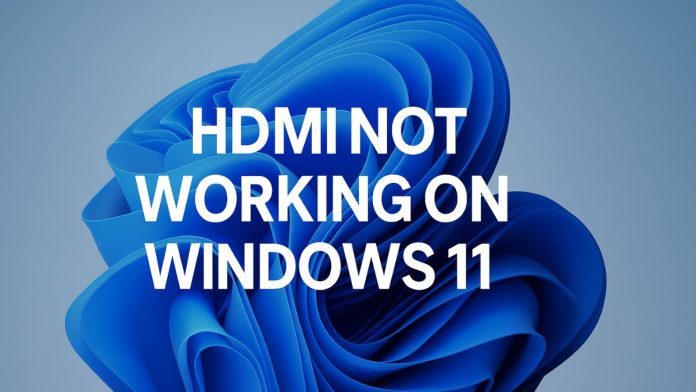HDMI has become the go-to standard for connecting monitors, TVs, and projectors to computers. Whether you’re working on a dual-screen setup, giving a presentation, or streaming media to a bigger screen, HDMI makes it easy to transmit both high-quality video and audio through a single cable. Windows 11, with its modern interface and advanced display features, is designed to support HDMI connections seamlessly. However, users may occasionally face the frustrating issue of an HDMI port not working properly.
This problem can manifest in several ways — from a completely unrecognized external display to distorted visuals or missing sound. Fortunately, these issues are usually fixable through a combination of hardware checks and software adjustments. Sometimes, the fix can be as simple as switching the HDMI cable or changing the input source. Other times, it might require updating drivers, adjusting system settings, or even inspecting the BIOS configuration.
This guide explores the most common reasons why your HDMI port might not be working in Windows 11 and provides step-by-step solutions to help you get your display back on track. Whether you’re a casual user or a tech enthusiast, these troubleshooting tips will help restore full functionality to your HDMI connection.
What is HDMI and How It Works
HDMI (High-Definition Multimedia Interface) is a digital interface used to transmit high-quality audio and video signals between compatible devices. It has become the industry standard for connecting computers, gaming consoles, Blu-ray players, set-top boxes, TVs, monitors, and projectors. HDMI simplifies connectivity by combining both audio and video into a single cable, eliminating the need for multiple wires and connectors.
HDMI supports a wide range of video resolutions — from standard definition (SD) to high definition (HD), Full HD (1080p), 4K, and even 8K in newer versions. It also transmits up to 32 channels of digital audio, supporting high-definition sound formats like Dolby TrueHD and DTS-HD Master Audio. Over time, HDMI has evolved through various versions (such as 1.4, 2.0, and 2.1), each offering increased bandwidth, faster refresh rates, higher resolutions, and enhanced features like HDR (High Dynamic Range) and eARC (Enhanced Audio Return Channel).
How HDMI Works
HDMI works by transferring uncompressed video and either compressed or uncompressed audio data through a 19-pin connector. When you connect an HDMI cable from a source device (like a PC or laptop) to a display device (like a monitor or TV), the devices communicate using a protocol called EDID (Extended Display Identification Data). This allows the source device to recognize the display’s capabilities — including supported resolutions, refresh rates, and audio formats — and adjust its output accordingly.
Windows 11 is designed to automatically detect and configure HDMI connections. When functioning properly, it should instantly mirror, extend, or transfer the display to the connected screen. However, if the handshake between devices fails, or if there are software, driver, or hardware issues, the HDMI connection may stop working — requiring troubleshooting to restore full functionality.
Common Symptoms of HDMI Port Issues
Before jumping into solutions, identify the specific symptoms. These can help you determine the underlying cause:
- No signal detected on the external monitor or TV
- Flickering screen or inconsistent display
- Audio works but video doesn’t, or vice versa
- External display not recognized in display settings
- Intermittent HDMI connection
- Displayed image is distorted or at incorrect resolution
Possible Causes of HDMI Problems in Windows 11
Several factors could prevent your HDMI port from functioning:
- Faulty HDMI cable or port
- Outdated or corrupt graphics drivers
- Incorrect display settings
- Hardware damage to the HDMI port
- Incorrect input source on the external device
- Windows 11 compatibility or update bugs
Preliminary Checks
Before trying software solutions, ensure the issue isn’t hardware-related:
- Check if the HDMI cable is properly connected on both ends.
- Try using a different HDMI cable.
- Inspect both the HDMI port on the PC and the display for dust or visible damage.
- Try connecting the same display to another device to confirm it works.
- Make sure your monitor or TV is powered on and set to the correct HDMI input.
Method 1: Restart and Reconnect
It may sound simple, but restarting often resolves many HDMI issues:
- Shut down your Windows 11 computer.
- Unplug the HDMI cable.
- Wait for about 30 seconds.
- Plug the HDMI cable back in.
- Power on the PC and check for display output.
This resets the connection and forces Windows to detect the external display.
Method 2: Inspect the HDMI Cable and Port
A damaged cable or port is one of the most common causes of HDMI problems:
- Use a known working HDMI cable.
- Try a different HDMI port on the display if available.
- Check for bent pins or loose connections in the port.
If the port feels loose or the cable wobbles when plugged in, consider a repair or professional inspection.
Method 3: Update Display Drivers
Outdated or incompatible display drivers can prevent HDMI output:
Steps:
- Press Windows + X and choose Device Manager.
- Expand the Display adapters section.
- Right-click your graphics card (e.g., Intel UHD, NVIDIA, AMD) and choose Update driver.
- Select Search automatically for drivers.
Windows will look for the latest drivers and install them if available.
Alternatively, visit the GPU manufacturer’s website (Intel, NVIDIA, or AMD) and download the latest driver manually.
Method 4: Roll Back or Reinstall Graphics Driver
Sometimes the latest drivers can cause compatibility issues:
Roll Back:
- Open Device Manager.
- Right-click your display adapter and choose Properties.
- Go to the Driver tab.
- Click Roll Back Driver if the option is available.
Reinstall:
- In Device Manager, right-click the adapter and choose Uninstall device.
- Restart your PC.
- Windows will attempt to reinstall the driver automatically.
Method 5: Choose the Correct Input Source
Ensure your external display is set to the right input:
- Use the remote or onboard controls to navigate to Input Source.
- Select HDMI 1, HDMI 2, etc., depending on where the cable is plugged in.
It’s surprisingly easy to overlook this step, especially with multi-input monitors or TVs.
Method 6: Extend or Duplicate Display Settings
Sometimes the display settings don’t automatically switch when an HDMI device is connected:
Steps:
- Press Windows + P to open the projection menu.
- Choose from:
- Duplicate – Mirrors your display.
- Extend – Expands your desktop.
- Second screen only – Uses only the HDMI screen.
If the display is still not recognized:
- Right-click on the desktop and choose Display settings.
- Click Detect under the Multiple displays section.
Method 7: Check Windows Updates
Microsoft regularly pushes patches for driver compatibility and display issues:
- Open Settings > Windows Update.
- Click Check for updates.
- Install all available updates, especially optional ones related to hardware or drivers.
After installing, restart your computer and test the HDMI output again.
Method 8: Try a Different Device or Port
To isolate the issue:
- Connect your PC to a different monitor or TV using the same HDMI cable.
- Try using a different port on your GPU or laptop (if available).
- Test with a different computer using the same display and cable.
This process helps determine if the problem lies with the PC, cable, or display.
When to Seek Professional Help
If none of the above methods work, the HDMI port may be physically damaged. Consider professional assistance if:
- HDMI output works intermittently or only when the cable is held at a certain angle.
- Port pins appear bent or broken.
- Your GPU or motherboard may have sustained electrical damage.
A technician can diagnose and replace the port or related components. In some laptops, the HDMI port is soldered to the motherboard, requiring board-level repair.
Conclusion
HDMI issues in Windows 11 are common but usually solvable with a systematic approach. Begin with basic checks—cables, ports, and settings. Then move on to updating or reinstalling drivers. If the problem persists, explore BIOS settings or external adapters. Rarely, hardware repair may be necessary.
By following this comprehensive guide, you can troubleshoot and resolve most HDMI port problems without needing expert assistance. With the growing reliance on multiple displays and external media, ensuring HDMI functionality is more important than ever in a Windows 11 environment.


![How to Play Bing Homepage Quiz? [2025 Updated] how-to-play-bing-homepage-quiz](https://www.internetoutsider.com/wp-content/uploads/2025/05/how-to-play-bing-homepage-quiz-218x150.jpg)

![How to Use WhatsApp Web? [Beginners Friendly] how-to-use-whatsapp-web-thumb](https://www.internetoutsider.com/wp-content/uploads/2025/05/how-to-use-whatsapp-web-thumb-218x150.jpg)


